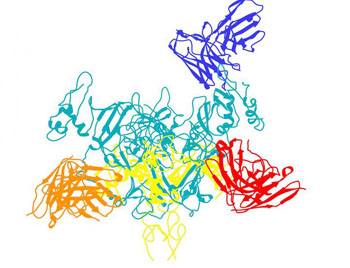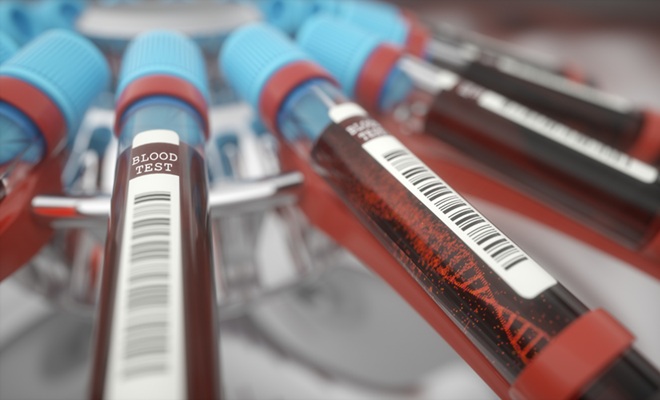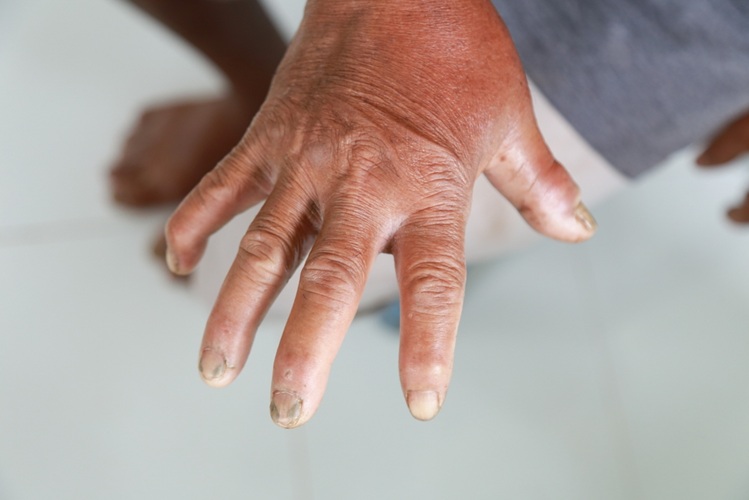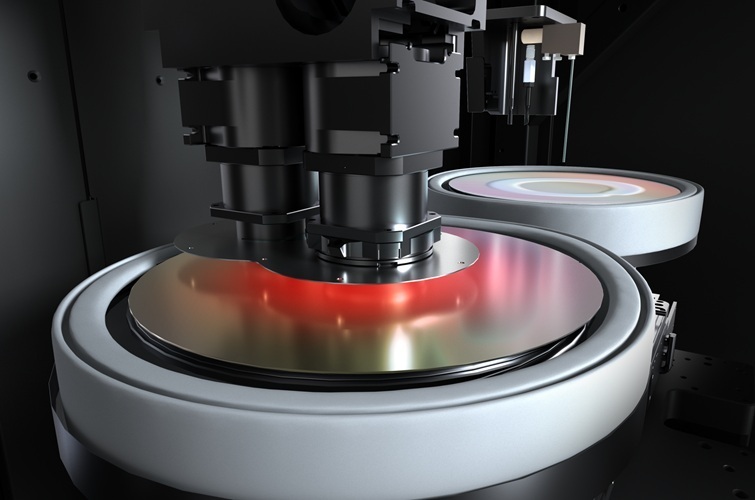High-Resolution Cryo-EM Images Increase Understanding of Anti-Ebola Drug
|
By LabMedica International staff writers Posted on 18 Aug 2016 |

Image: A molecular model showing the experimental antibody drug ZMapp binding to the Ebola virus, here targeting the virus\'s GP protein (Photo courtesy of Dr. Andrew Ward and Dr. Jesper Pallesen, Scripps Research Institute).
High-resolution cryo-electron microscopy images have revealed more precise information as to how the experimental drug ZMapp binds to the Ebola virus and provide insights into how the drug prevents growth of the pathogen.
ZMapp, which was developed by Mapp Biopharmaceutical (San Diego, CA, USA), is composed of three monoclonal antibodies (mAbs) that have been chimerized by genetic engineering. The components are chimeric monoclonal antibody c13C6 from a previously existing antibody cocktail called MB-003 and two chimeric mAbs from a different antibody cocktail called ZMab, c2G4 and c4G7.
Investigators at The Scripps Research Institute (La Jolla, CA, USA) used high-resolution cryo-electron microscopy (cryo-EM) techniques to study the interaction between ZMapp and two Ebola glycoproteins. The more abundant glycoprotein was the secreted dimeric glycoprotein (sGP). Despite the abundance of sGP during infection, little was known regarding its structure or functional role. A minor product, resulting from transcriptional editing, was the transmembrane-anchored, trimeric viral surface glycoprotein (GP). GP mediated attachment to and entry into host cells, and was the intended target of antibody therapeutics. Because large portions of sequence were shared between GP and sGP, it had been hypothesized that sGP may potentially subvert the immune response or may contribute to pathogenicity.
Researchers have historically relied on NMR and X-ray diffraction techniques to determine the structures of molecular complexes and proteins that play a role in the causes of various disease states. Structural information about a variety of medically important proteins and drugs has been obtained by these methods. Cryo-EM is a complementary analytical technique that provides near-atomic resolution without requirements for crystallization or limits on molecular size and complexity imposed by the other techniques. Cryo-EM allows the observation of specimens that have not been stained or fixed in any way, showing them in their native environment while integrating multiple images to form a three-dimensional model of the sample.
In the August 8, 2016, online edition of the journal Nature Microbiology, the investigators presented the cryo-electron microscopy structures of GP and sGP in complex with GP-specific and GP/sGP cross-reactive antibodies undergoing human clinical trials. The structure of the sGP dimer in complex with both an sGP-specific antibody and a GP/sGP cross-reactive antibody, permitted the investigators to unambiguously assign the oligomeric arrangement of sGP and compare its structure and epitope presentation to those of GP.
"This sGP protein is tremendously important," said Dr. Erica Ollmann Saphire, a professor at the Scripps Research Institute. "This is the roadmap we need to target the right molecules in infection. Eighty to 90% of what Ebola virus makes in infection is this shed molecule. It is like a smoke screen, and we need to know where it is similar to our target GP and where it is different."
Related Links:
Mapp Biopharmaceutical
The Scripps Research Institute
ZMapp, which was developed by Mapp Biopharmaceutical (San Diego, CA, USA), is composed of three monoclonal antibodies (mAbs) that have been chimerized by genetic engineering. The components are chimeric monoclonal antibody c13C6 from a previously existing antibody cocktail called MB-003 and two chimeric mAbs from a different antibody cocktail called ZMab, c2G4 and c4G7.
Investigators at The Scripps Research Institute (La Jolla, CA, USA) used high-resolution cryo-electron microscopy (cryo-EM) techniques to study the interaction between ZMapp and two Ebola glycoproteins. The more abundant glycoprotein was the secreted dimeric glycoprotein (sGP). Despite the abundance of sGP during infection, little was known regarding its structure or functional role. A minor product, resulting from transcriptional editing, was the transmembrane-anchored, trimeric viral surface glycoprotein (GP). GP mediated attachment to and entry into host cells, and was the intended target of antibody therapeutics. Because large portions of sequence were shared between GP and sGP, it had been hypothesized that sGP may potentially subvert the immune response or may contribute to pathogenicity.
Researchers have historically relied on NMR and X-ray diffraction techniques to determine the structures of molecular complexes and proteins that play a role in the causes of various disease states. Structural information about a variety of medically important proteins and drugs has been obtained by these methods. Cryo-EM is a complementary analytical technique that provides near-atomic resolution without requirements for crystallization or limits on molecular size and complexity imposed by the other techniques. Cryo-EM allows the observation of specimens that have not been stained or fixed in any way, showing them in their native environment while integrating multiple images to form a three-dimensional model of the sample.
In the August 8, 2016, online edition of the journal Nature Microbiology, the investigators presented the cryo-electron microscopy structures of GP and sGP in complex with GP-specific and GP/sGP cross-reactive antibodies undergoing human clinical trials. The structure of the sGP dimer in complex with both an sGP-specific antibody and a GP/sGP cross-reactive antibody, permitted the investigators to unambiguously assign the oligomeric arrangement of sGP and compare its structure and epitope presentation to those of GP.
"This sGP protein is tremendously important," said Dr. Erica Ollmann Saphire, a professor at the Scripps Research Institute. "This is the roadmap we need to target the right molecules in infection. Eighty to 90% of what Ebola virus makes in infection is this shed molecule. It is like a smoke screen, and we need to know where it is similar to our target GP and where it is different."
Related Links:
Mapp Biopharmaceutical
The Scripps Research Institute
Latest BioResearch News
- Genome Analysis Predicts Likelihood of Neurodisability in Oxygen-Deprived Newborns
- Gene Panel Predicts Disease Progession for Patients with B-cell Lymphoma
- New Method Simplifies Preparation of Tumor Genomic DNA Libraries
- New Tool Developed for Diagnosis of Chronic HBV Infection
- Panel of Genetic Loci Accurately Predicts Risk of Developing Gout
- Disrupted TGFB Signaling Linked to Increased Cancer-Related Bacteria
- Gene Fusion Protein Proposed as Prostate Cancer Biomarker
- NIV Test to Diagnose and Monitor Vascular Complications in Diabetes
- Semen Exosome MicroRNA Proves Biomarker for Prostate Cancer
- Genetic Loci Link Plasma Lipid Levels to CVD Risk
- Newly Identified Gene Network Aids in Early Diagnosis of Autism Spectrum Disorder
- Link Confirmed between Living in Poverty and Developing Diseases
- Genomic Study Identifies Kidney Disease Loci in Type I Diabetes Patients
- Liquid Biopsy More Effective for Analyzing Tumor Drug Resistance Mutations
- New Liquid Biopsy Assay Reveals Host-Pathogen Interactions
- Method Developed for Enriching Trophoblast Population in Samples
Channels
Clinical Chemistry
view channel
New Method Uses Pulsed Infrared Light to Find Cancer's 'Fingerprints' In Blood Plasma
Cancer diagnoses have traditionally relied on invasive or time-consuming procedures like tissue biopsies. Now, new research published in ACS Central Science introduces a method that utilizes pulsed infrared... Read more
Carbon Nanotubes Help Build Highly Accurate Sensors for Continuous Health Monitoring
Current sensors can measure various health indicators, such as blood glucose levels, in the body. However, there is a need to develop more accurate and sensitive sensor materials that can detect lower... Read moreMolecular Diagnostics
view channel
Gene-Based Blood Test Accurately Predicts Tumor Recurrence of Advanced Skin Cancer
Melanoma, an aggressive form of skin cancer, becomes extremely difficult to treat once it spreads to other parts of the body. For patients with metastatic melanoma tumors that cannot be surgically removed... Read more
Blood Test Could Identify Patients at Risk for Severe Scleroderma
Systemic sclerosis, also known as scleroderma, causes the hardening of the skin and connective tissues. In many cases, the disease can also damage vital organs, including the heart, kidneys, lungs, and... Read moreHematology
view channel
New Scoring System Predicts Risk of Developing Cancer from Common Blood Disorder
Clonal cytopenia of undetermined significance (CCUS) is a blood disorder commonly found in older adults, characterized by mutations in blood cells and a low blood count, but without any obvious cause or... Read more
Non-Invasive Prenatal Test for Fetal RhD Status Demonstrates 100% Accuracy
In the United States, approximately 15% of pregnant individuals are RhD-negative. However, in about 40% of these cases, the fetus is also RhD-negative, making the administration of RhoGAM unnecessary.... Read moreImmunology
view channel
Stem Cell Test Predicts Treatment Outcome for Patients with Platinum-Resistant Ovarian Cancer
Epithelial ovarian cancer frequently responds to chemotherapy initially, but eventually, the tumor develops resistance to the therapy, leading to regrowth. This resistance is partially due to the activation... Read more
Machine Learning-Enabled Blood Test Predicts Immunotherapy Response in Lymphoma Patients
Chimeric antigen receptor (CAR) T-cell therapy has emerged as one of the most promising recent developments in the treatment of blood cancers. However, over half of non-Hodgkin lymphoma (NHL) patients... Read moreMicrobiology
view channel
Handheld Device Delivers Low-Cost TB Results in Less Than One Hour
Tuberculosis (TB) remains the deadliest infectious disease globally, affecting an estimated 10 million people annually. In 2021, about 4.2 million TB cases went undiagnosed or unreported, mainly due to... Read more
New AI-Based Method Improves Diagnosis of Drug-Resistant Infections
Drug-resistant infections, particularly those caused by deadly bacteria like tuberculosis and staphylococcus, are rapidly emerging as a global health emergency. These infections are more difficult to treat,... Read more
Breakthrough Diagnostic Technology Identifies Bacterial Infections with Almost 100% Accuracy within Three Hours
Rapid and precise identification of pathogenic microbes in patient samples is essential for the effective treatment of acute infectious diseases, such as sepsis. The fluorescence in situ hybridization... Read morePathology
view channel
New Error-Corrected Method to Help Detect Cancer from Blood Samples Alone
"Liquid biopsy" technology, which relies on blood tests for early cancer detection and monitoring cancer burden in patients, has the potential to transform cancer care. However, detecting the mutational... Read more
"Metal Detector" Algorithm Hunts Down Vulnerable Tumors
Scientists have developed an algorithm capable of functioning as a "metal detector" to identify vulnerable tumors, marking a significant advancement in personalized cancer treatment. This breakthrough... Read more
Novel Technique Uses ‘Sugar’ Signatures to Identify and Classify Pancreatic Cancer Cell Subtypes
Pancreatic cancer is often asymptomatic in its early stages, making it difficult to detect until it has progressed. Consequently, only 15% of pancreatic cancers are diagnosed early enough to allow for... Read moreTechnology
view channel
Pain-On-A-Chip Microfluidic Device Determines Types of Chronic Pain from Blood Samples
Chronic pain is a widespread condition that remains difficult to manage, and existing clinical methods for its treatment rely largely on self-reporting, which can be subjective and especially problematic... Read more
Innovative, Label-Free Ratiometric Fluorosensor Enables More Sensitive Viral RNA Detection
Viruses present a major global health risk, as demonstrated by recent pandemics, making early detection and identification essential for preventing new outbreaks. While traditional detection methods are... Read moreIndustry
view channel
Cepheid and Oxford Nanopore Technologies Partner on Advancing Automated Sequencing-Based Solutions
Cepheid (Sunnyvale, CA, USA), a leading molecular diagnostics company, and Oxford Nanopore Technologies (Oxford, UK), the company behind a new generation of sequencing-based molecular analysis technologies,... Read more
Grifols and Tecan’s IBL Collaborate on Advanced Biomarker Panels
Grifols (Barcelona, Spain), one of the world’s leading producers of plasma-derived medicines and innovative diagnostic solutions, is expanding its offer in clinical diagnostics through a strategic partnership... Read more
























